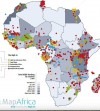African airlines will need 1,100 new deliveries of passenger and cargo aircraft by 2040, according to Airbus' Global Market Forecast (GMF) 2021. This will bring the total fleet to 1,440 aircraft, up from 680 in 2019.
This essentially represents a transition to next-generation aircraft such as the A220, A320neo Family, A330neo and A350, bringing a significant improvement in efficiency and a significant reduction in carbon emissions per passenger.
The growth of aviation activity in Africa between now and 2040 will be driven in particular by an average increase in GDP of 2.8% CAGR over the period. A development that should be based over the next 20 years on tourism and intra-regional trade.
Airbus expects air traffic in Africa to reach 2019 levels between late 2023 and early 2025. Globally, cargo is already up 9% above pre-crisis levels, and more than 23% on air alone. African continent. While freight to and from Africa will increase 2.5 times by 2040, O&D passenger traffic on the continent is expected to more than double (2.3) also over the same period.
This outlook is explained by the fact that the fundamental drivers of traffic demand remain unchanged: economic growth faster than the world average, a young and growing population, urbanization and the development of the middle class. The potential for air transport in Africa remains significant due to the limited land transport infrastructure, the abundance of natural resources that facilitate trade and the many tourism opportunities.
Over the past decade, significant improvements have been made in the sector across the continent, including the establishment of the Single African Air Transport Market (SAATM) and the modernization of national airline fleets. Thus, carriers such as Ethiopian Airlines, Air Senegal, South African Airways, Air Côte d’Ivoire, EgyptAir, Uganda Airlines and Air Tanzania, today operate some of the most modern and innovative aircraft in the world, such as the A350 , the A330neo, the A320neo and the A220.
The ability of the aeronautics industry to promote economic development on the African continent is undeniable. Not only does aviation keep people moving, it also promotes regional integration, creates jobs and enables internal, intra-African and global trade. According to the International Air Transport Association, in Africa, the sector directly supports 6.2 million jobs and contributes $56 billion to the continent’s regional GDP.





























Réagissez à cet article